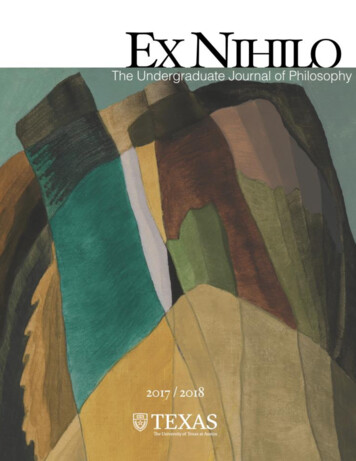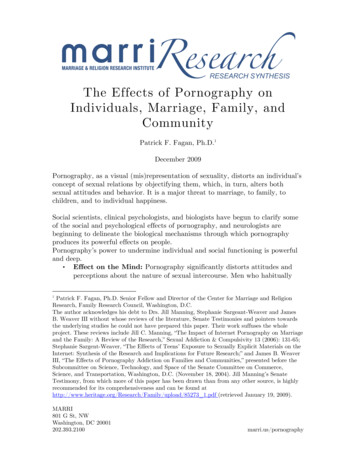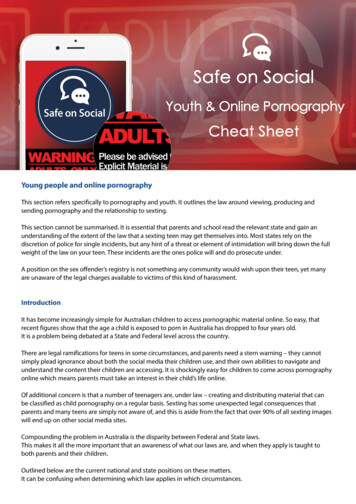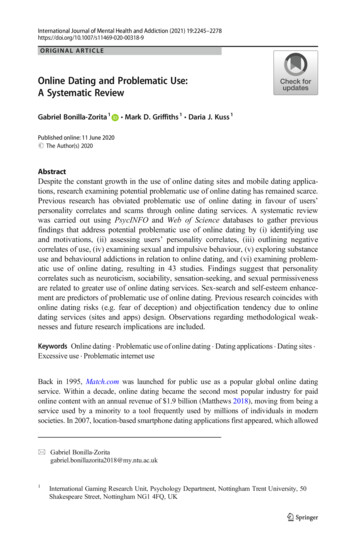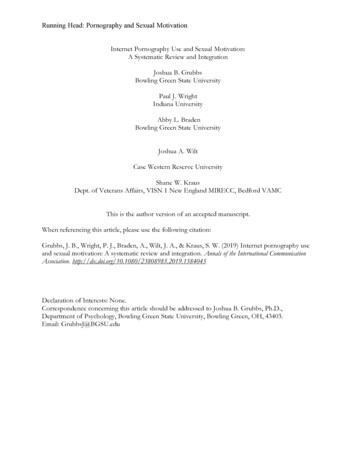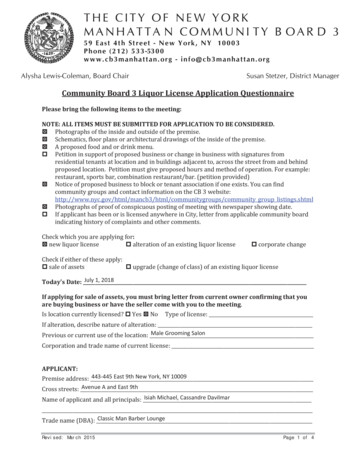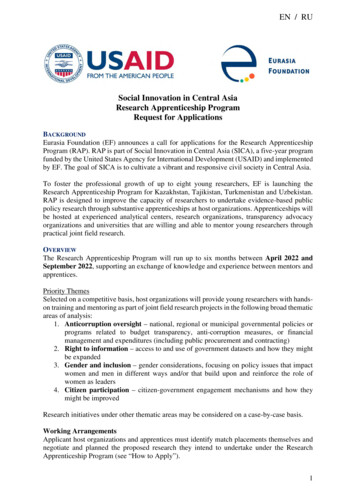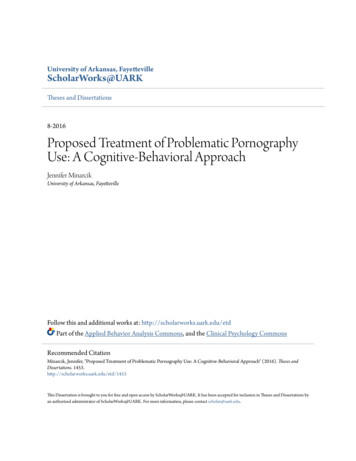
Transcription
University of Arkansas, FayettevilleScholarWorks@UARKTheses and Dissertations8-2016Proposed Treatment of Problematic PornographyUse: A Cognitive-Behavioral ApproachJennifer MinarcikUniversity of Arkansas, FayettevilleFollow this and additional works at: http://scholarworks.uark.edu/etdPart of the Applied Behavior Analysis Commons, and the Clinical Psychology CommonsRecommended CitationMinarcik, Jennifer, "Proposed Treatment of Problematic Pornography Use: A Cognitive-Behavioral Approach" (2016). Theses andDissertations. 1453.http://scholarworks.uark.edu/etd/1453This Dissertation is brought to you for free and open access by ScholarWorks@UARK. It has been accepted for inclusion in Theses and Dissertations byan authorized administrator of ScholarWorks@UARK. For more information, please contact scholar@uark.edu.
Proposed Treatment of Problematic Pornography Use:A Cognitive-Behavioral ApproachA dissertation submitted in partial fulfillmentof the requirements for the degree ofDoctor of Philosophy in Clinical PsychologybyJennifer MinarcikTexas A&M UniversityBachelor of Arts in Psychology, 2008University of Houston-Clear LakeMasters of Arts in Clinical Psychology, 2010August 2016University of ArkansasThis dissertation is approved for recommendation to the Graduate Council.Dr. Ana BridgesDissertation DirectorDr. Matthew FeldnerCommittee MemberDr. Denise BeikeCommittee Member
AbstractAs pornography use increases across the general population, mental health professionalsare encountering more patients who present symptoms of sexual addictions and sexualcompulsivity (Cooper et al., 2001). Never before have pornographic materials been so accessibleto consumers. Viewing pornography is related to many negative consequences for theindividual, including impairment of academic and professional functioning, subjective distress,and sexual compulsivity (Cooper et al., 1999a; Manning, 2006). Studies found pornography useby an individual typically leads to a decline in relationship and sexual satisfaction (Bridges,2008a). Despite the growth in research related to problematic pornography use, to date therehave been very few research studies assessing the efficacy of interventions. The current studyevaluated a 12-session cognitive-behavioral treatment protocol developed by Bridges andMinarcik (2012) for the reduction of problematic pornography use and related impairments inmen who present with “pornography addiction”. Participants (n 12) were randomly assigned toa 1, 2, or 3-week baseline prior to the initiation of treatment. Primary measures assessed dailyminutes of pornography use, self-reported addiction to pornography, sexual cognitions, sexualcompulsivity, hypersexual behavior, and pornography craving. Secondary measures were sexualcognitions, mood, relationship satisfaction, and OCD symptoms. There were consistentreductions in weekly pornography use, as measured by self-report daily monitoring forms, whichsupported the first hypothesis. Self-reported reductions in sexual cognitions, hypersexualbehavior, sexual compulsivity, and pornography craving from pre- to post-treatment tended to bereliable and clinically significant, supporting the second hypothesis. One exploratory questionrevealed the cognitive content of the treatment protocol did not add incremental efficacy aboveand beyond the behavioral treatment content. Another exploratory question demonstrated the
treatment show specificity, such that treatment gains were specific to sexual behaviors and notevidence in other measures of psychiatric distress. The last exploratory question supported thatbaseline pornography use did not relate to treatment outcomes, suggesting this treatment protocolwas equally effective for low- and high-frequency pornography users. Overall, this protocol wasfound to be effective at reducing problematic pornography use. Future directions includeconducting long-term follow ups of the treatment efficacy and conducting dismantling studies toenhance understanding of the relative impact of different treatment components.Key Words: pornography use, compulsive sexual behavior, sexually explicit material, Internetuse, addictive behaviors, randomized-control trial
AcknowledgmentThis project would not have been possible without the help of several people:First, I would like to extend my eminence gratitude to Dr. Ana J. Bridges who providedexcellent mentorship, hours of supervision, and supportive guidance.Thanks to my dissertation committee members who helped shaped this project: Drs.Denise Beike and Matthew Feldner.Thanks to Dr. Jeffery M. Lohr for his feedback in the initial shaping of this project.Many thanks to the students of the Interpersonal System laboratory. Many helpers wereinstrumental in assisting with data organization. Especially Debbie Gomez who helped with thecollection of follow-up data and create a tracking system deserving of its own Noble Prize. Also,special recognition to my right-hand girls: Desiree Potter and Caitlin Hancock.The Marie Wilson Howells Committee for providing funds to help support the financialcosts associated with running this project.
DedicationThis dissertation is first and foremost dedicated to my husband. I am eternally grateful forhis endless love, friendship, and often much-needed humor. In addition, his willingness to livelike a bachelor for over seven years and tolerance of frequent, long drives has facilitated thispersonal dream.This dissertation is also dedicated to my parents. Your love and support has been crucialthroughout my life (in all endeavors) and this process was no exception. Alas, I would beremised to forget the love of my brother, niece, grandparents, in-laws, and aunt who havecontinually supported and cheered me.
Table of ContentsI.Introduction 1A.Conceptualization of Problematic Pornography Use . 4Obsessive Compulsive Spectrum Disorder 5Addictive Disorder . 6Impulsive Control Disorders . 8Hypersexuality – Emerging New Diagnostic Nomenclature . 9B.Behavioral Analysis of Pornography Use . 10C.Effects of Problematic Pornography Use .12D.Psychosocial Interventions 14Acceptance and Commitment Therapy .15Cognitive-Behavioral therapy – Single Case Design .15Cognitive-Behavioral therapy – Treatment development and initial piloting .16Proposed Study .18Hypothesis 1 .18Hypothesis 2 .18Question 1 .19Question 2 .19Question 3 .19II.Method 19A.Participants . 19B.Compensation .20C.Design .21E.
D.Procedures . 21E.Measures .22Daily tracking sheets . 22Clear-Lake Addiction to Pornography Scale .23Cognitive and Behavioral Outcome Scales 23Sexuality Compulsivity Scale 24Hypersexual Behavior Inventory 25Pornography Craving Questionnaire .25Mini-International Neuropsychiatric Interview .26Dyadic Adjustment Scale 26Obsessive-Compulsive Inventory-Revised . 27Depression Anxiety Stress Scale .28Client Satisfaction Questionnaire .28Analytic Plan .29Hypothesis 1 .29Hypothesis 2 .29Exploratory Aim 1 .29Exploratory Aim 2 .30Exploratory Aim 3 .30III.Results 30A.Treatment Acceptance 30Retention 30Satisfaction .30F.
B.Primary Hypotheses 31Time spent viewing pornography .31Self-reported measures of problematic pornography use .32Exploratory Questions 33Question 1 .34Question 2 .34Question 3 .36IV.Discussion .37A.Treatment Acceptability and Components 39B.Theoretical Mechanisms 41C.Comparisons to Other Treatments .42D.Limitations .43E.Future Directions 46V.Tables 48VI.Figures .63VII.References .80C.VIII. Appendix . 94
List of TablesTable 1. Proposed Diagnostic Criteria for Hypersexual Disorder, Pornography Type49Table 2. Minutes and percent reduction of average pornography use duration acrosspre-treatment and treatment phase 50Table 3. Individual Scores and Change Status on CLAPS 52Table 4. Individual Scores and Change Status on CBOS psychological/spiritual scale53Table 5. Individual Scores and Change Status on HBI 54Table 6. Individual Scores and Change Status on SCS 55Table 7. Individual Scores and Change Status on PCQ 56Table 8. Tau-U Analyses of Daily Pornography Use (in minutes) Within Phases ofTreatment Protocol 57Table 9 Tau-U Analyses of Daily Pornography Use (in minutes) Across Phases of58Treatment Table 10. Individual Scores and Change Status on the CBOS Financial Subscale 59Table 11. Individual Scores and Change Status on DASS-21 Depression Subscale 60Table 12. Individual Scores and Change Status on the DASS-21 Anxiety Subscale 61Table 13. Individual Scores and Change Status on the DASS-21 Stress Subscale 62Table 14. Individual Scores and Change Status on the DAS 63Table 15. Individual Scores and Change Status on the OCI-R 64
List of FiguresFigure 1. Average weekly pornography use by baseline condition .65Figure 2: Average weekly pornography use for TX01 .66Figure 3: Average weekly pornography use for TX02 .67Figure 4: Average weekly pornography use for TX03 .68Figure 5: Average weekly pornography use for TX04 .69Figure 6: Average weekly pornography use for TX05 .70Figure 7: Average weekly pornography use for TX06 .71Figure 8: Average weekly pornography use for TX07 .72Figure 9: Average weekly pornography use for TX08 .73Figure 10: Average weekly pornography use for TX09 .74Figure 11: Average weekly pornography use for TX10 .75Figure 12: Average weekly pornography use for TX11 76Figure 13: Average weekly pornography use for TX12 77Figure 14. Average Pre-treatment Porn Use by Differences in Sexual Cognitions Preand Post-Treatment 78Figure 15. Average Pre-treatment Porn Use by Differences in Sexual Compulsivity Preand Post-Treatment 79Figure 16. Average Pre-treatment Porn Use by Differences in Hypersexuality BehaviorsPre- and Post-Treatment 80Figure 17. Average Pre-treatment Porn Use by Differences in Pornography CravingPre- and Post-Treatment 81
Proposed Treatment of Problematic Pornography Use: A Cognitive-Behavioral ApproachWhile pornography as it is conceptualized today has existed since the late 1800s,significant increases in pornography availability and use have recently prompted researchers toexplore its impact on the individual user and interpersonal relationships (Bridges, 2008a;Schneider, 2000a; Schneider, 2000b). As technology has advanced with the advent of theInternet, sexually explicit material distribution also has adapted to new digital formats, thusincreasing availability. Currently, nearly 4.2 million pornography websites (12% of totalwebsites) are available for use, and every second, over 3,000 is being spent on pornography(Ropelato, 2010). Never before have pornographic materials been so accessible to consumers. Inaddition to the growing use of online sexually explicit materials, the use of pornographicmaterials in general has increased. For example, in 1992, 405 million adult videos were sold orrented while in 2006, the number more than doubled to 957 million (Ropelato, 2010). A largeproportion of the population views pornography. The majority of college students (males andfemales) report viewing pornography in their lifetime (approximately 90%) and almost half(40%) report viewing pornography weekly (O’Reilly, Knox, & Zusman, 2007). However,excessive use that interferes with well-being and functioning is relatively rare. For instance, alarge survey of Internet users found that 8% engaged in excessive online pornography viewing(defined as 11 hours per week) that negatively impacted an important area of life, such as workor romantic relationships (Cooper, Scherer, Boies, & Gordon, 1999b). In a more recent study,68% of respondents (N 1,047) from an online survey titled “Personality, Beliefs, and Behavior”indicated viewing pornography in their lifetime and 40% viewed in the past year (Grubbs et al.,2015). Furthermore, this study found that the perception of psychological addiction topornography use - regardless of the amount of time spent viewing pornography - was strongly1
related to psychological distress (e.g., depression, anxiety, perceived stress, anger) even whenaccounting for traits of neuroticism and socially desirable responding (Grubbs et al, 2015).As the use of pornography increases, mental health professionals are encountering morepatients who present with symptoms of sexual addiction and compulsivity (Briken et al., 2007,Kafka, 2009), with Internet usage cited as the primary reason for the increase in these difficulties(Short et al., 2012). The “Triple-A Engine” theory may account for the increased use ofpornography on the Internet (Cooper, 1998). This theory states that the Internet has led todramatic increases in pornography use in the population because pornography is more accessible,affordable, and can be accessed in a seemingly anonymous way.What exactly is pornography? Justice Potter Steward infamously stated "I shall not todayattempt further to define that short-hand description [e.g., 'hard-core pornography']; and perhapsI could never succeed in intelligibly doing so. But I know it when I see it." (Jacobellis v. Ohio,1964). While research has recently begun to assess the use and consequences of pornography,often the authors do not give a definition of pornography or utilize definitions consistently(Manning, 2005; Short et al., 2012). Sapolsky and Zillmann (1981) proposed two categories ofpornography: (1) soft core – or erotica, where the media has nudity and sexually suggestivescenes and (2) “hard core” - explicit sexual behavior (including penetration), and can be violentor degrading (Russell, 1998). Rea (2001) summarized pornography definitions from the literatureinto six different categories:(i) those that define ‘pornography’ as the sale of sex for profit, (ii) those thatdefine it as a form of bad art, (iii) those that define it as portraying men or womenas, as only, or only as sexual beings or sexual objects, (iv) those that define it as aform of obscenity, (v) those that define it as a form of (or contributor to)oppression, and (vi) those that define it as material that is intended to produce orhas the effect of producing sexual arousal. (p. 123)2
The author concludes that, ‘the most pervasive definitions in the literature onpornography are those that hold that the defining feature of pornography is that it is intended toproduce sexual arousal or in fact has the effect of producing sexual arousal’’ (p. 132, italics in theoriginal).For many decades, researchers have argued that sexually explicit material can be broadlygrouped into two types: erotica (non-degrading sexually explicit depictions of people engaging inmutually enjoyable sexual activity) and pornography (sexually explicit depictions of sexualactivity that includes themes of violence, degradation, sexism, and racism; Steinem, 1978).Researchers have long documented the relative negative effects of violent and degradingpornography, compared to erotica, on viewers (Hald, Malamuth, & Yuen, 2010; Mulac, Jansma,& Linz, 2002; Peter & Valkenburg, 2006; Senn & Radtke, 1990).Degrading pornography is becoming more accessible, particularly on the Internet (Barron& Kimmel, 2000; Sun, Bridges, Wosnitzer, Scharrer, & Liberman, 2008). Men tend to reportpornography as arousing while women more commonly report it as degrading (Daneback,Traeen, & Mansson, 2009). Compared to women, men are introduced to pornography at ayounger age, view larger amounts of pornography and, as time progresses, expose themselves toincreasingly violent and degrading content (Johansson & Hammaŕen, 2007; Sabina et al., 2008;Wallmyr & Welin, 2006).Research has supported concerns about the increased access of degrading pornography(Mulac et al., 2002; Sun et al., 2008), particularly concerns that consumers may habituate to thedegradation and violence and seek ever-more arousing stimuli (Grundner, 2000). Specifically,one survey revealed that participants (regardless of gender) who endorsed a higher frequency ofpornography use also rated degrading pornography as more arousing than participants who3
endorsed less frequent pornography use (Anton, Minarcik, McGahan, & Bridges, 2010). Theseresults are consistent with theories that consumers of pornography may habituate and becomedesensitized to the content of frequently consumed pornography (see, for instance, Linz,Donnerstein, & Penrod, 1988), leading to a decrease in sexual arousal after viewing the samefilm or similar content and a need for increasingly extreme and/or degrading content to achieve asimilar level of arousal (Bridges, 2010). This is consistent with assertions that more frequentconsumption of pornography is associated with higher arousal to more degrading materials,which in turn have been shown to have negative impacts (Bridges, 2008b).Conceptualization of Problematic Pornography UseIn addition to not defining adequately what constitutes pornography, many authors do notdescribe what constitutes problematic pornography use. Definitions range from hours per weekspent viewing to self-reported measures of distress or impairment (Cooper et al., 1999b;Wetterneck, Burgess, Short, Smith, & Cervantes, 2012). These definitional inconsistenciesmake reviewing the literature and comparing findings across studies more difficult.The Diagnostic and Statistical Manual of Mental Disorders, 5th edition (DSM-5;American Psychiatric Association [APA], 2013) does not officially recognize problematicpornography use as a mental disorder. Therefore, people with problematic pornography use arecurrently diagnosed with a Sexual Disorder, Not Otherwise Specified. One of the proposed newdisorders considered for inclusion in the 5th edition of the DSM included Hypersexual Disorder(with a subtype of pornography), which best exemplifies what researchers in this area have beencalling pornography addiction or compulsive pornography use (Kafka, 2010). However,insufficient data on the disorder led to it being eliminated from inclusion in the revised DSM.4
The limited body of research on problematic pornography use has struggled with how toaccurately conceptualize and diagnosis this behavior. One could conceptualize viewingpornography as a paraphilic behavior, such as a form of voyeurism. However, it is important tonote research generally promotes the idea that the actual viewing of pornography is nonparaphilic, but the content of what is being viewed (e.g., child pornography) could be associatedwith a paraphilia (Kafka, 2010). Online pornography use has recently been included in a broadergroup of behaviors known as cybersex; where the internet facilitates sexually gratifyingbehaviors (see Wéry & Billieux, 2015 for a diagnostic conceptualization of problematiccybersex). Instead, three broad disorder classes have been used to explain the development andmaintenance of problematic pornography use.Obsessive-compulsive spectrum disorder. “Sexual compulsivity” was first introducedby Quadland (1983, 1985) to describe the voluntary, risk-taking behavior associated withhypersexual, promiscuous behavior. Sexual compulsivity is described as a manifestation of anobsessive-compulsive disorder (OCD; Coleman, 1990). OCD is a specific anxiety disorder(APA, 2013) characterized by intrusive or unwanted images and thoughts (obsessions), andhabitual responses designed to reduce anxiety or tension (compulsions). Sexual compulsivity,according to the OCD model, involves behavior driven by dysphoric anxiety in conjunction withirrational sexual obsessions (Coleman, 1990). In this formulation, sexually compulsive behaviorsare an attempt to reduce anxiety or other drive states. The time spent fantasizing about thecompulsive behavior characterizes the sexual obsessions.The conceptualization of problematic pornography use as an obsessive-compulsivespectrum disorder has shortcomings. For instance, generally those with OCD are described as‘risk-adverse’ or harm avoidant while problematic pornography users are ‘risk-takers’ or5
sensation seekers (Kafka, 2010). Furthermore, empirical studies find comorbid OCD to bepresent in only 10-14% of men meeting criteria for hypersexual disorder; furthermore, OCD isnot the most prevalent comorbid anxiety disorder in people who present with compulsive sexualbehaviors (Black, Kehrberg, Flumerfelt, & Schlosser, 1997; Kafka & Prentky, 1994, 1998).Addictive disorder. Oxford (1978, 1985) has suggested that even without the presenceof an externally derived substance of abuse, appetitive behaviors could resemble an addictionlike behavioral syndrome. While problematic pornography use fits this description, most of theconceptual literature has focused on the area of sexual behaviors more broadly. The term andclinical concept of sexual addiction was widely used after Carnes’ (1983) book, Out of theShadows: Understanding Sexual Addiction. The proposed addiction model by Carnes (1989)first suggested that a sexual behavior is repetitively misused as a way to self-medicate or selfsoothe dysphoric mood states. Next, Carnes describes an escalation of the sexual behavior astolerance builds and risk-taking increases (e.g., multiple partners, sex without a condom). Then,an individual begins to ‘lose control’ at the same time as negative interpersonal and intrapersonalconsequences happen. Lastly, when reducing the sexual behavior, Carnes argues the user goesthrough a withdrawal state. Proponents of the addictions model, later expanded by others (e.g.,Goodman, 2008), propose that all addictive process (including ingestion of psychoactivesubstances of abuse, pathological gambling, and sexual addition) share commonalities acrossbiological, psychological, and developmental factors, which in turn affect three behavioralprocesses: motivation-reward, behavioral inhibition, and affect-regulation (Goodman, 1997,2008).However, there is certainly controversy in the scientific literature about whetherproblematic pornography use should be considered an addiction (e.g., Griffiths, 2000; Schneider,6
1994). Even though compulsive behaviors (similar to pornography use, such as pathologicalgambling, and compulsive shopping) have been referred to as behavioral ‘addictions,’ theyhistorically have been diagnostically classified as impulse-control disorders (APA, 1980, 1987,1994, 2000). However, in the most recent edition of the DSM-5 (APA, 2013) gambling disorderhas been categorized as a “Substance-Related and Addictive Disorder” to reflect the newresearch that demonstrates this behavior’s effect on the brain’s reward system, one that is akin tosubstance use disorders.Labeling appetitive behaviors as addictions is also potentially problematic. Sexual,sleeping, and eating/drinking behaviors are all appetitive or “drive” behaviors that propagatesurvival of a species (Kafka, 2010). These biopsychosocially-mediated behaviors have extensivecentral nervous system states, such as “cravings” and satiation, which are partially driven byneurotransmitters. Many psychiatric (e.g. mood disorders, schizophrenia) and neurological (e.g.,brain injury) conditions can disinhibit the appetitive drives. When any given drive (such as thesexual drive) is in a state of deprivation (perceived or actual), there are accompanying mentalprocesses (e.g., thoughts, images, fantasies) and overt behaviors that are motivated to assuage thedeprived state. Despite recognition of cravings that motivate survival-relevant behaviors like sexand eating, applying an addiction model to an appetitive drive can be problematic. First, there isa lack of empirical evidence to support the notion of tolerance and withdrawal for sexualbehaviors (Wines, 1997). Second, if sexual behaviors were to be classified as addictions, whatcould that mean for other behaviors that have a biological substrate and are necessary for thesurvival of a species? As Kafka (2010) argues, when someone is depressed, they may frequentlyengage in a pleasurable activity (namely, sleep); however, they do not have a “sleep addiction”.Another example is those diagnosed with schizophrenia that develop excessive thirst do not have7
a “thirst addiction”. In these examples, the dysregulated appetitive drives do not satisfy theconditions of a behavioral addiction (such as impulsive engagement in drinking, sleeping, or sex,as described by Carnes, 1983; 1989). Kafka (2010) asserts that clearer characterizations of sexualdisorders such as problematic pornography use require additional biological and clinicalinvestigation.Impulse control disorders. An impulse-control disorder model has been suggested asthe best fit for excessive sexual behaviors (including problematic pornography use; Barth &Kinder, 1987). In the DSM-IV (APA, 2000), impulse control disorders have been characterizedby:The failure to resist an impulse, drive or temptation to perform an act that is harmful tothe person or others A person may feel an increased sense of tension or arousal beforecommitting the act and then experiences pleasure, gratification, or relief at the time theact is committed. Following the act, there may or may not be regret, self-reproach orguilt. (p. 663)More recently, DSM-5 (2013) has created a new chapter highlighting disruptive, impulsecontrol, and conduct disorders. The diagnosis of other DSM disorders, including paraphilias,states that the disorder may have features that involve problems of impulse control. Furthermore,several researchers have proposed that the constructs of “sexual risk-taking” (Bancroft et al.,2003, 2004; Kalichman & Rompa, 1995, 2001), “sexual sensation seeking” (Kalichman &Rompa, 1995; Zuckerman, 1979, 1983), and “sexual impulsivity” (Hoyle, Fefjar, & Miller,2000) have considerable overlap.Nevertheless, the conceptualization of problematic pornography use as an impulsecontrol disorder has limitations. For instance, research does not support the idea that impulsivityis the maintaining mechanism for problematic Internet pornography (IP) use (Wetterneck et al.,2012). In an online survey (N 94 adults), there was no difference in a measure of trait8
impulsivity when comparing problematic IP users and non-problematic IP users. Furthermore,there was no difference between IP users and non-IP users. This suggests that impulsive traitsmay not be implicated in problematic pornography use and further research is still needed toexplore the role of coping with impulsive urges specifically related to this disorder.Hypersexuality – Emerging new diagnostic nomenclature. Hypersexuality developedfrom the concept of paraphilic-related disorders, which acknowledged the manifestation ofsexual problems with characteristics akin to obsessive-compulsive disorders (Coleman, 1987,1990, 1992), addiction disorders (Carnes, 1983, 1989, 1991; Goodman, 1997), and disorders ofsexual desire (Kafka, 1997a, 1997b; Kafka & Hennen, 1999; Kafka & Prentky, 1992).Hypersexual disorder is defined as “a sexual disorder associated with increased or disinhibitedexpressions of sexual arousal and desire in association with a dimension of impulsivity” (Kafka,2010, p. 393). Hypersexual disorder is associated with (1) sexual preoccupations or sexual“obsessions” (e.g., spending increased time engaging in sexual fantasies and behaviors), and (2)“loss of control” (such as a significant degree of voluntary impairment characterized bydisinhibition, impulsivity, compulsivity, or behavioral addiction). Table 1 outlines the possiblediagnostic criteria for Hypersexuality, pornography type (adapted from Kafka, 2010, p.379).Even though distinct models of psychopathology have been proposed to characterize theintensity, frequency, and impulsivity-associated component of problematic pornography use,many of these ‘distinct’ models do in fact have considerable overlap (Kafka, 2010). For instance,the concepts of impulsivity and compulsivity recently have been characterized as dimensionsfound in sexual impulsions, sexual compulsions, paraphilias, and sexual additions (Hollander &Rosen, 2000; McElroy, Phillips, & Keck, 1994). Furthermore, the substance dependenceliterature describes “impulsivity” as characteristics of early stages of substance use, while9
“compulsivity” is related with later stages of substance dependence (Koob, 2008). Thisframework is suitable for Hypersexual Disorder when the problema
evaluated a 12-session cognitive-behavioral treatment protocol developed by Bridges and Minarcik (2012) for the reduction of problematic pornography use and related impairments in men who present with "pornography addiction". Participants (n 12) were randomly assigned to a 1, 2, or 3-week baseline prior to the initiation of treatment.
